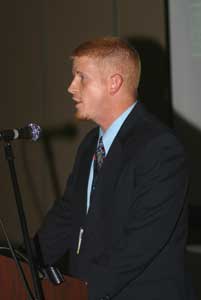Golden Alga (Prymnesium parvum) in Texas
Workshop Abstracts
Overview of Texas Hatchery Management of Golden Alga, Prymnesium parvum
 Greg
Southard
Greg
Southard
A. E. Wood Fish Hatchery, Inland Fisheries Division, Texas Parks and Wildlife Department, 507 Staples Road, San Marcos, Texas 78666 USA
Abstract.--During the spring of 2001, the toxin-producing alga Prymnesium parvum was identified as the cause of widespread fish mortality at the Texas Parks and Wildlife Department (TPWD) Inland Fisheries Dundee State Fish Hatchery, resulting in complete loss of the striped bass Morone saxatilis and hybrid striped bass (M. saxatilis x M. chrysops) production for that year. Also greatly impacted were largemouth bass Micropterus salmoides and smallmouth bass M. dolomieu brood fish and future brood fish, as well as rainbow trout Oncorhynchus mykiss, channel catfish Ictalurus punctatus, and koi carp Cyprinus carpio production. This alga was also identified as responsible for a large fish kill at Possum Kingdom Reservoir, which is the source water for another TPWD fish hatchery. The TPWD formed the P. parvum task force, with the goal of developing strategies to effectively control this alga in order to produce fish. A basic management plan was created, including methods to identify and quantify P. parvum, monitor toxicity levels, and investigate physical and chemical control methods to counter blooms and toxic events. Identification and enumeration of P. parvum are accomplished using a light microscope, hemacytometer, and trained personnel. A standard bioassay, adapted from Israeli fish culturists, is used to monitor the ichthyotoxin at sub-lethal concentrations in order to warn biologists of impending toxicity. A wide variety of physical and chemical control methods were evaluated for their effectiveness to destroy P. parvum cells or mitigate toxicity. Applications that were deemed effective include UV sterilization of hauling tank water, the use of potassium permanganate to mitigate toxicity, and ammonium sulfate and copper sulfate to destroy this toxin-producing alga. Although these methods have enabled TPWD to produce fish at these P. parvum-afflicted facilities, some challenges remain. Chemical treatments are temporary. Current P. parvum management practices are time consuming and labor intensive. More sensitive and efficient methods are needed.
Download
presentation  (PDF 397.3 KB). If
you are unable to access this document, please contact
us for an alternative format.
(PDF 397.3 KB). If
you are unable to access this document, please contact
us for an alternative format.